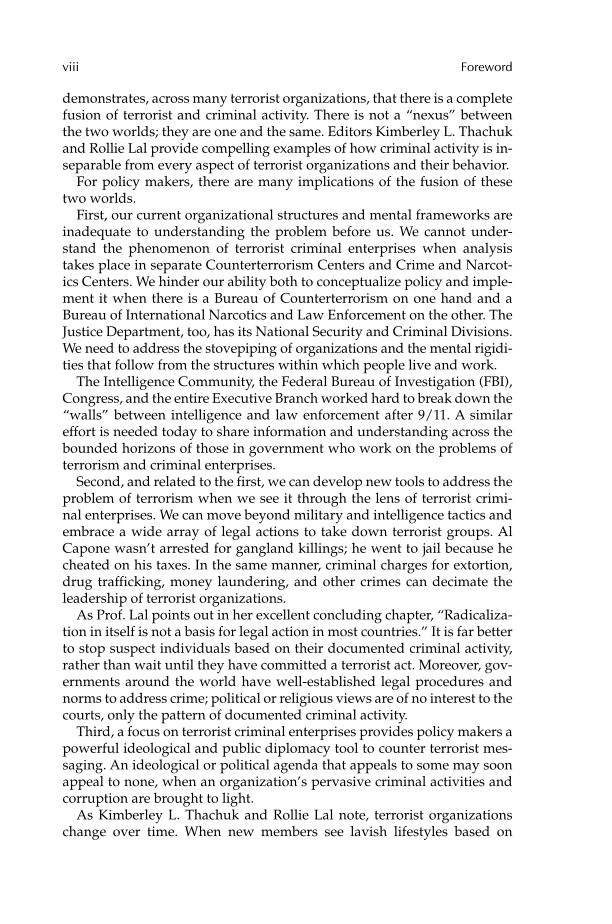viii Foreword demonstrates, across many terrorist organizations, that there is a complete fusion of terrorist and criminal activity. There is not a “nexus” between the two worlds they are one and the same. Editors Kimberley L. Thachuk and Rollie Lal provide compelling examples of how criminal activity is in- separable from every aspect of terrorist organizations and their behavior. For policy makers, there are many implications of the fusion of these two worlds. First, our current organizational structures and mental frameworks are inadequate to understanding the problem before us. We cannot under- stand the phenomenon of terrorist criminal enterprises when analysis takes place in separate Counterterrorism Centers and Crime and Narcot- ics Centers. We hinder our ability both to conceptualize policy and imple- ment it when there is a Bureau of Counterterrorism on one hand and a Bureau of International Narcotics and Law Enforcement on the other. The Justice Department, too, has its National Security and Criminal Divisions. We need to address the stovepiping of organizations and the mental rigidi- ties that follow from the structures within which people live and work. The Intelligence Community, the Federal Bureau of Investigation (FBI), Congress, and the entire Executive Branch worked hard to break down the “walls” between intelligence and law enforcement after 9/11. A similar effort is needed today to share information and understanding across the bounded horizons of those in government who work on the problems of terrorism and criminal enterprises. Second, and related to the first, we can develop new tools to address the problem of terrorism when we see it through the lens of terrorist crimi- nal enterprises. We can move beyond military and intelligence tactics and embrace a wide array of legal actions to take down terrorist groups. Al Capone wasn’t arrested for gangland killings he went to jail because he cheated on his taxes. In the same manner, criminal charges for extortion, drug trafficking, money laundering, and other crimes can decimate the leadership of terrorist organizations. As Prof. Lal points out in her excellent concluding chapter, “Radicaliza- tion in itself is not a basis for legal action in most countries.” It is far better to stop suspect individuals based on their documented criminal activity, rather than wait until they have committed a terrorist act. Moreover, gov- ernments around the world have well-established legal procedures and norms to address crime political or religious views are of no interest to the courts, only the pattern of documented criminal activity. Third, a focus on terrorist criminal enterprises provides policy makers a powerful ideological and public diplomacy tool to counter terrorist mes- saging. An ideological or political agenda that appeals to some may soon appeal to none, when an organization’s pervasive criminal activities and corruption are brought to light. As Kimberley L. Thachuk and Rollie Lal note, terrorist organizations change over time. When new members see lavish lifestyles based on
Document Details My Account Print multiple pages
Print
You have printed 0 times in the last 24 hours.
Your print count will reset on at .
You may print 0 more time(s) before then.
You may print a maximum of 0 pages at a time.





































































































































































































































